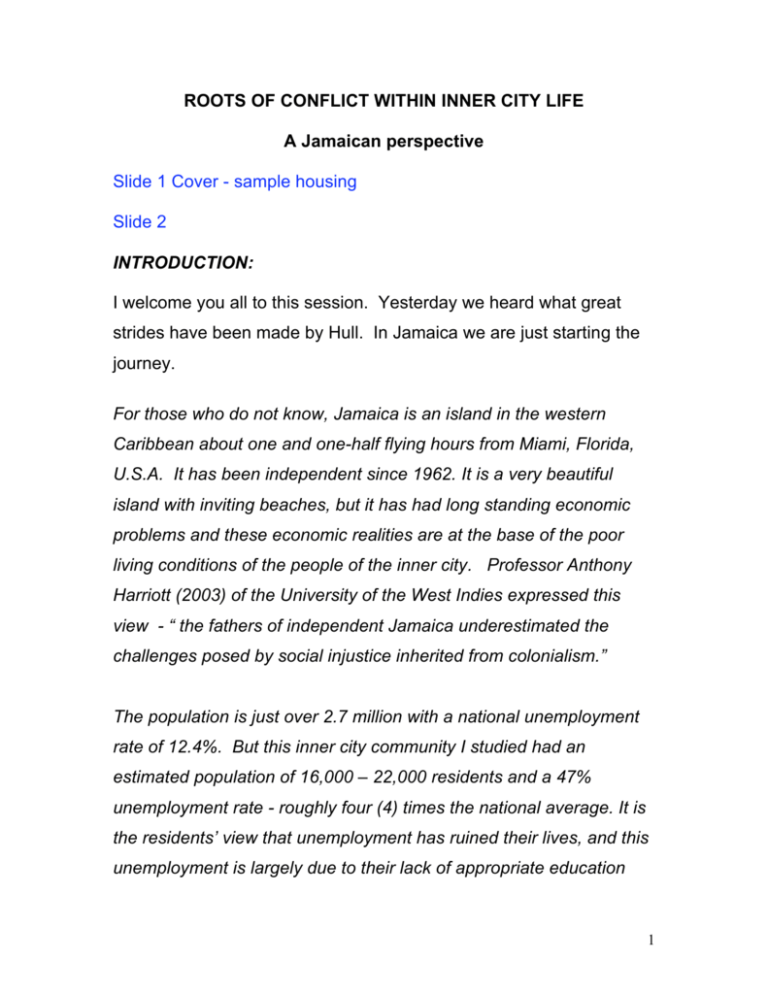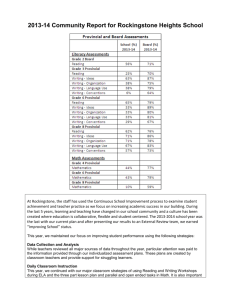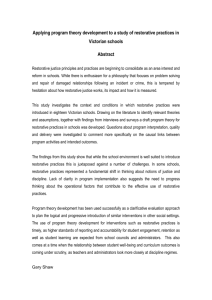Roots of Conflict Within Inner-City Life: A Jamaican Perspective
advertisement

ROOTS OF CONFLICT WITHIN INNER CITY LIFE A Jamaican perspective Slide 1 Cover - sample housing Slide 2 INTRODUCTION: I welcome you all to this session. Yesterday we heard what great strides have been made by Hull. In Jamaica we are just starting the journey. For those who do not know, Jamaica is an island in the western Caribbean about one and one-half flying hours from Miami, Florida, U.S.A. It has been independent since 1962. It is a very beautiful island with inviting beaches, but it has had long standing economic problems and these economic realities are at the base of the poor living conditions of the people of the inner city. Professor Anthony Harriott (2003) of the University of the West Indies expressed this view - “ the fathers of independent Jamaica underestimated the challenges posed by social injustice inherited from colonialism.” The population is just over 2.7 million with a national unemployment rate of 12.4%. But this inner city community I studied had an estimated population of 16,000 – 22,000 residents and a 47% unemployment rate - roughly four (4) times the national average. It is the residents’ view that unemployment has ruined their lives, and this unemployment is largely due to their lack of appropriate education 1 and skills’ training for the marketplace. In turn this impacts their living conditions and quality of life. The frustrations of daily living aggravate the human pre-disposition to conflict. Unacceptable and inappropriate behaviour in the home, community and street is the result. Conflict, the stuff of life, has so substantially disrupted community life that many cry “We want justice”. This community is characteristic of 8 contiguous communities and many urban areas throughout the island. Slide 3 Outline of presentation In my presentation today I will try to answer the question “Why are some inner cities prone to conflict?” by examining the findings of my empirical study on a Jamaican inner city community. Why did I do this study? I did it as a basis for my Master’s thesis and at the suggestion of the Dispute Resolution Foundation of Jamaica which wanted local material with which to use in devising management systems for the several categories of conflict surfacing and causing grief to the nation. I identified twelve (12) main roots of conflict in three (3) areas of community life - Living Conditions, Education and Personal Security and the extent of the influence of the historical past. I will examine one of the roots of conflict through the lens of the Social Discipline Window. I will also share with you a resident’s story and how her challenges can be accommodated in the WITH box of the Organizational Change Window and what has been done so far in the community and in Jamaica. 2 Slides 4 & 5 – The Historical Past THE HISTORICAL PAST in this context refers to the plantation society and colonialism. Below is an imagery of the influence of the historical past. I found it had an overarching effect of the three areas investigated and that this shadow manifested itself in the presenting features, inter alia, enumerated in the next slide. (Poor parenting style is highlighted because I will examine this feature later on.) Some features: • Continuation of dysfunctional education being carried on to keep the lower stratum in their own compartment. 3 • Pre-occupation with present time – what they can get now. • Substantial numbers having to be pushed to achieve • Early programming to follow commands • Involvement in cult rituals and superstition • Use by gangs of methods of control reminiscent of the past • Poor Parenting style • Stuck in a mindset • Residents not invited to participate in the creation of solutions for the upliftment of the community • Lack of empowerment and initiative Slide 6 - 12 Main Roots of Conflict I was able to identify twelve (12) main roots of conflict. © 4 Unemployment & scarcity of resources Overcrowded homes & poor infrastructure Widespread indiscipline Poor parenting skills Distrust of the police Lack of interpersonal skills Peer pressure Ignorance of facts Poor quality of family life Unmet needs Dysfunctional education General disrespect resulting in loss of identity and dignity Slide 7 - Living Conditions What did I find? LIVING CONDITIONS - Dilapidated, overcrowded housing – with 4 -5 persons to one (1) small room - bereft of basic conveniences like bathrooms, running water, individual kitchens – having outdoor or communal bathrooms (rustic at best). A substantial number of the residents was under 35years of age - they had insufficient money for their basic needs and sometimes no money at all; those with jobs had occasional work or were self 5 employed trying to eke out a living on the streets selling what they could find to sell. They had no capital or business skills and talents for music, craft work etc were largely not showcased and marketable because of lack of expertise and marketing skills. High unemployment and underemployment were largely responsible for keeping the residents in these awful conditions as they paid no rent for these Government-owned buildings. In this type of situation, the smallest difference of opinion had far reaching effects in many cases, as brute force and violence were the tools used to solve issues. Slide 8 - Effects of Living Together N=30 6 Lack of personal space and privacy were expressed by 67%-70% of the respondents as undesirable effects. Fed up, stressed out, inconvenienced and frustrated, describe how significant numbers of them feel. Superimposed on these living conditions is a lack of interpersonal and communication skills. Many of the respondents seemed to have realized that this type of living calls for behavioral changes and expressed to me a need for knowledge of interpersonal skills. Hertzberg et al (1959) asked this question - “What do people want from their job?” The responses they got then are the same these residents gave - they want jobs to cover their living expenses, to take care of their families and to be comfortable at home. Slide 9 – Education ( I will spend some time on this topic as it is largely responsible for the high unemployment) EDUCATION - Among the majority in the 35+ age group, there was a high illiteracy level e.g. they cannot access their birth certificates they are not aware of government programs (like funeral grants) to assist them. Nearly all were in need of skills’ training to better access the job market. Some vocational and other training were available but poorly accessed by the residents who seemed not to 7 care for the offerings. They had no input in what is offered, and as much of it is simply to keep them in them own compartment, they reject them. Their self styled community leader assessed the situation thus “lack of education is the biggest problem of the community”. Yet by admission 73% of this age group attended primary and secondary level education, but 90% of them did not complete the latter level and this has left them without the key to unlock the doors of opportunity. This impacted parents’ ability to help their children with their home work and knowledge of facts to make informed decisions. It was abundantly apparent that the parents of present teenagers received the type of education that did not prepare them for the realities of today’s world. So when they say “unemployment has ruined our lives” this is inextricably linked to and controlled by the type of education they received at school age. They resort to creative self employment - “hustling” – small scale selling – like buying 3 tins of sardines and 2 lbs of rice and selling the latter in smaller quantities. In fact in the inner city one is surprised at what small portions one can buy – like a half of a half of a boxed meal! - a reality catering to the means of the residents! However the sellers make little difference between capital and sales returns. Their daily returns are not consistent – they are run off the streets by the authorities and what they make is insufficient for their daily needs – hence basics like food are scare in the home. 8 Many educators have done research on this period and found that when the 35 - 40 age group was in school, the education system was decreed by the ruling classes. They determined WHO should be educated and TO WHAT EXTENT. Professor Errol Miller (1971) [Head of the Education Dept of the University of the West Indies] expressed the opinion that education for the lower classes was dysfunctional and dominated by practical subjects for the lower end of the market. Persaud (1976) [another educator in his doctoral thesis] referred to teachers as “gatekeepers/systems maintenance” and not “promoters and developers of the full potential of the student”. He presented a quotation from Barbados, a sister West Indian colony “classical education for the elite – 3Rs for the working classes” – this was colonial thinking and was carried over and therefore this problem is systemic. Slide 10 - Personal Safety and Security PERSONAL SAFETY AND SECURITY Without personal space in the home, life is a series of behavioral acts that stem from frustration and stress. The political landscape has not helped as when in power the political parties have brought their adherents to certain sectors of the inner city and mere streets function as the political divide giving rise to fury at election time and 9 drive by shootings from time to time. Domestic violence flares up suddenly as physical violence is used to solve problems, real or perceived. The residents experience fear at home and in the community. They especially fear the police, their alleged protector, and have no trust in them as they function in a way that frightens them. Slide 11 - Feared most in Home and In Community Despite the fact that there has been a truce with their warrior neighbours, they were not taking chances and many logs, drums, tires, and obstacles could be seen on the roadways, especially at night, to impede traffic. 10 [As a response to their dilemma the residents have largely resorted to the establishment of their own government, complete with security as protective gatekeepers/crews man the streets and street corners. The police are regarded as invaders. General research by Gayle & Levy (2007) [Forced Ripe –sponsored by the UK Dept of Development] and Harriott (2000) [page 80 of Forced Ripe] has established that the Jamaican police socially cleanse and oppress the poor and that this has not changed since 1865 when they were established to crush the resistance of the natives.] Slide 12 – Selection of one root for examination I have set out the 12 main roots of conflict so we may quickly consider whether or not Restorative Practices are suitable. The first four (4) Unemployment & Scarcity of resources, Poor housing and infrastructure, Dysfunctional education and Ignorance of facts are systemic, but that does not mean that the residents could not in circles consider how they have been hurt and what it would take to repair that harm and maybe invite some leaders of Government and 11 the private sector to listen as to how this has been affecting them and perhaps build an effective lobby to go forward. The other eight (8) are ideally suitable for the application of Restorative Practices as they deal with relationships. Next I will consider one of the roots of conflict – Poor Parenting skills in the lens of the Social Discipline Window. Slide 13 – Poor Parenting Skills and the Social Discipline Window You will notice that of the four (4) boxes in this window, three (3) of them show the different types of responses that have been made in parents’ relationships with their children. The Fourth box ( the WITH box) shows what could have been done. 12 Slide 14 - Rosie’s Challenge Rosie’s Story” Rosie, an Ice Cream Vendor told me her story which I now share with you. Like most people she lived free in the dilapidated housing owned by government. She had no money for herself and three (3) young children. She was able to get a job sweeping the streets a few days per week. A Christian minister helped her get an ice cream shop (Canadian model) which she installed near her dwelling, and she took some of her earnings and bought ice cream, cones and 13 napkins. The residents supported her as far as they were able and with the day’s returns she bought more ice cream and did brisk sales on weekends. The immediate neighbours got jealous and started throwing words at her, drove away her customers and made her life miserable. With help she tried. Her neighbours hated her success! Slide 15 - Rosie’s challenge and the “WITH” box People living together do not always see things in the same way, they have different needs, goals and aspirations and many times hurt each other in trying to achieve their objectives and conflicts arise. The response to conflict is often punitive, but with changed lenses responses can be supportive. So how did the WITH box in the Social Organizational Window help Rosie? • Rosie visited the facilitator at the Peace & Justice Centre and asked for help. 14 • The facilitator visited the neighbors and asked whether or not they would meet with Rosie and discuss the problem. She fully explained the process and expectations. • Supporters of both were identified by the facilitator. • All were invited to a nearby school to meet and discuss the problems in a circle. • All were led by the facilitator in the use of affective statements and to ask affective questions so that they may hear how each has been affected by what happened and feelings were thoroughly examined. The facilitator demonstrated the use of fair process by ensuring that all had a chance to provide input and have an opportunity to have a say and discuss possible solutions. • Relationships changed as they talked to each other for the first time about the problem and heard how each was affected. • They were ready to generate creative options to repair the harm done (e.g. on inconvenience to the neighbors; on the neighbors’ taking advantage of opportunities for business with Rosie’s clientele; the settling of business hours and a host of other things for their mutual convenience.) 15 • As they talked and had open and honest communication, the tenseness left and they began to relax and smile at each other. • When last I heard – both were doing thriving business on weekends and harmony was restored. Slide 16 – Done in this community so farS WHAT HAS BEEN DONE IN THIS COMMUNITY SO FAR: • The establishment of a Peace and Justice Centre for mediation services with over 30 residents trained as mediators, some of whom have now been trained as restorative facilitators. • Conferences in a safe place with youths from the area to promote relational change. • Outings for young persons to promote a sense of community. • Young persons have been encouraged to serve and help the senior citizens and provide food and entertainment for them on certain occasions to show that they are part of the community. • The organization of events to showcase musical talents and creative talents in arts and crafts. 16 Workshops by church members dealing with business and • personal development. Slide 17- What has Jamaica done so far WHAT HAS JAMAICA DONE SO FAR i. Mediations, Circles, Conferences (recently) for party and group disputes. ii. The law was amended in 1989 to permit Resident Magistrates to refer certain offences and issues to Alternative Dispute Resolution and if these are amicably settled by the parties, no record is kept of the incident. Since 2006 in the civil jurisdiction of the Supreme Court, there has been automatic referral to mediation after a defence was filed not only to clear the huge backlog of cases awaiting trial but to help foster relational change. iii. An organization called Peace Management Initiative (PMI), an NGO, has frequently intervened in disputes and gun battles by warring sectors of communities and their 17 contiguous neighbours and has succeeded in establishing Peace Treaties. iv. Victims’ Support Units have been established in all 14 Parishes of the island. [The island is divided into parishes] v. Prison initiatives have included more attempts at rehabilitation, the taking of responsibility, and the restoration of self esteem and self worth, like having a prisoner-manned radio station within prison walls. vi. Attempts have been made by church affiliated groups to curb re - offending, and to work with deportees who have special problems as substantial numbers grew up in the first world and have no cultural connections with Jamaica. vii. There have been interventions to tackle school violence and behavioural change strategies have been initiated. Slide 18 - (Government Initiatives) GOVERNMENT INITIATIVES: • Island wide consultations to sensitize the nation on restorative practices. 18 • Pilot programmes have been rolled out in four (4) volatile communities have been rolled out to encourage grass roots leadership and to sensitize people about relational change. • 155 persons have already been as restorative facilitators. • Educational officers have been targeted for training in restorative practices and some have already been trained. • There has been substantial movement from concept paper to policy document to inform new legislation to promote restorative practices e.g. to afford parties the opportunity to choose restorative practices rather than court trial in certain offences and in certain pre-charge and post-charge instances. At last, victims will be included in the justice system and will have a right of intervention in what happens to those who offend them. These are some of the provisions in the intended legislation. 19 Slide 19 SO WHAT DOES IT TAKE TO COMMENCE THIS TRANSFORMATION? Talk - Listen - Use Fair Process and Affective Language to restore relationships, to encourage offenders to accept responsibility and repair the harm done – so that individuals, the family, the community and the nation may live in peace. This is only a first step in the huge challenge ahead! WE LOOK FORWARD IN HOPE TO A NEW DAY! October 14, 2010. Ursula Khan 20 21 Roots of Conflict Within Inner City Life: A Jamaican Perspective Ursula Khan, LL.B. Hons., M.A. (Attorney-at-law) and Dispute Resolution Foundation of Jamaica Introduction Jamaica Population: 2,700,400 Unemployment rate: 12.4% Kingston Inner city Community Estimated population: 16,000 – 22,000 Pop. >35 years of age: 37.6% Self employment to some extent: 55% Unemployed: 47% (Source: Preliminary Data April 2010 - Statistical Institute of Jamaica) Outline • Introduction • “Why are some inner cities prone to conflict?” • Empirical study findings - Roots of Conflict identified - 3 areas of Jamaican inner city life & the Historical past • One of the Roots examined through the lens of the Social Discipline Window • Rosie’s Story & her challenges using the “WITH” box • What has been done so far • What does it take to go forward Results from an Empirical Study Factors Contributing to Conflict Historical Past Living Conditions Dysfunctional Education Security Concerns CONFLICT Historical Past, Plantation Society & Colonialism • " ! ! • $ !ime - ! " ! • • " ! • % • " • " • • " • !% & 12 Main Roots of Conflict Living Conditions • Dilapidated housing • Over crowdedness (4-5 persons/small room) • No personal space within home • Bereft of basic conveniences • Outdoor communal bathrooms • Lack of running water • Insufficient or no money for basic needs due to 47% unemployment • No capital and/or inadequate business skills to earn living from self employment Effects of Living Conditions • • • • Lack of privacy Frustration/Fed up Stress Quarrelsome compounded by lack of - communication skills - interpersonal skills Education • Lack of education is “the biggest problem of the • • • • community” 73% attended primary & secondary level education 90% did not complete secondary level education Personal development impacted by – Lack of education & skills’ training – No jobs – High unemployment No accident - Systemic design - Ruined their lives Personal Safety & Security • Behavioral acts - Stem from stress & frustration - Lead to physical abuse & violence • Lack of social & personal skills to handle disagreements lead to use of force • Partisan politics cause division among community residents • Residents fear police Feared Most in Home & Community • • • • • • • && & $ $! $ ! ! !' ' !!$' *% • $% • %' " • $! • ! !&%)! • !"%! • % Selection of One Root for Examination • Unemployment & Scarcity of resources • Poor Housing & Infrastructure • Dysfunctional Education • Ignorance of facts • Widespread indiscipline • Poor parenting skills • Distrust of the police • Lack of interpersonal skills • Peer pressure • Poor quality of family life • Unmet needs • General disrespect resulting in loss of identity & dignity “Poor Parenting Skills” Through Lens of the Social Discipline Window TO (Punitive) - Abusive beating - Deprivation of food - Burning with hot pot covers - Sending child out to street to beg - Encouraging sexual encounters with elder persons WITH (Restorative) - Exercising control & Refusing to accept inappropriate behaviour in a supporting way - Hugging and showing love to child - Making time for child and teaching values - Family time together - Ensuring child’s safety before going out NOT (Neglectful) FOR (Permissive) - Leaving child to look after himself - Not caring whether or not child comes home at night - No home support for school - Buying “bling” for self rather than books for child - Leaving young child unattended whilst at allnight dance - Allowing child to choose undesirable friends - Not insisting on homework being done - Allowing child to stay away from school and up late watching TV - Permitting promiscuous behaviour “ Rosie’s Challenge” • “Rosie” had a free place to live but no • • • • • money for self & 3 young children Swept street a few days per week Christian minister helped her set up an ice cream shop Took some of her earnings & bought ice cream, cones & napkins Residents supported her Immediate neighbours got jealous - started throwing words at her - drove away her customers - made her life miserable Her neighbours hated her success! • • • • • • • ,$ ",&$" ") "$ , ") &) # #" ,& ""$$( #&,$$%) +*$ $ ) & " ( &) * #&&$& # " ) Done in this Community so far “For” to “With” Box • Mediation services offered - 30 residents trained as mediators –some as restorative facilitators • Conferences/Circles in safe place with youths to promote relational change • Outings to build relationships • Service to the aged by youths • Organization of musical & other events to showcase talent • Workshops dealing with personal & business development What Has Jamaica Done So Far? • Mediation(1994) Circles & Conferences (recently) • Law amended to permit referrals of some offences & suits by Resident Magistrates’ Courts & automatic referrals to Alternative Dispute Resolution (ADR) in civil actions • Peace Management Initiatives in community warfare • Victim Support Units in each of the 14 Parishes • Greater attempt at rehabilitation of prisoners • Church affiliated groups to curb re-offending & work with deportees • School interventions - promote behavioural/relational change (circles successfully used) Government Initiatives Restorative Practices to help people Talk, Listen & Revolutionize Communities’ Response to Wrongdoing Islandwide consultations to sensitize the nation on Restorative Practices Training of 155 Restorative Facilitators Training of Educational Officers in Restorative Practices Pilot programs rolled out in 4 volatile communities New Legislation to introduce choice of Restorative Practices Processes in certain types of offenses and the intervention of victims What does it take? Let’s talk Let’s listen Let’s restore relationships Let’s repair harm so that individuals, the community & the nation may live in PEACE A HUGE CHALLENGE! We look forward to a new day! Contact Information Ursula Khan 6c Halfway Tree Road, Kingston 10, Jamaica, W.I. Phone: 876-929-2889 / 876-960-4066 Email: ukhan7876@yahoo.com Dispute Resolution Foundation of Jamaica The Peace Centre, 5 Camp Road, Kingston, Jamaica, W.I. Phone: 876-906-2456 / 876-908-3657 / 876-960-6160 Email: drf@drfja.org







